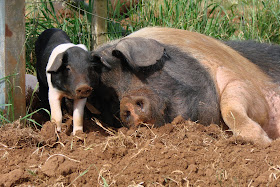

Suffolk sheep evolved from the mating of Norfolk Horn ewes with Southdown rams in the Bury St Edmunds area. They were known as Southdown Norfolks, or "Black faces."
The Norfolk Horned sheep, now rare, were a wild and hardy breed. They were black-faced, light, fleeced sheep. Both sexes were horned. The upland regions of Suffolk, Norfolk and Cambridge on the southeastern coast of England are very rugged and forage is sparse. It was this dry, cold and windy area in which the Norfolk breed adapted itself to traveling great distances for food, thereby developing a superbly muscular body.


Suffolks developed around the rotational system of farming in East Anglia, grazing on grass or clover in the summer. After weaning the ewes could be put on salt marshes or stubbles. Swedes, turnips or mangels were grazed in the winter in a very labour intensive system with a fresh area fenced off each day. Lambing was in February or March, outdoors in the fields with a hurdle shelter or in open yards surrounded by hurdles and straw.
The breed expanded rapidly, with the first flock in Ireland established in 1891, in 1895 in Scotland and 1901 in Wales. From the earliest days sheep were exported around the world, to Austria, France, Germany, Switzerland, Russia, North and South America and the colonies (that's us in New Zealand!). Suffolks are now the most dominant sheep meat breed throughout the world. Suffolk cross lambs are ideally suited to today's trade requirements. They have an excellent lean meat ratio, large eye muscle, well-muscled legs, and succulent, well-textured meat.






(newly shorn)



The Wessex Saddleback is a striking looking black pig with a white belt, which includes the front legs, around the body. (Historically, the Wessex developed alongside the Essex Saddleback, which differed only in having white hind feet and tail tip.) The ears are lopped forward.
The Wessex is both prolific and hardy, and does well as an outdoor pig – being bred originally as as a baconer (specialist bacon producer).
A Wessex Saddleback breed society was formed in Britain in 1918, but the breed (or a very similar one) may have been imported into New Zealand prior to this date. Sometime before 1905 a Mr Hardcastle described black pigs with a white stripe over the shoulder as being plentiful among the wild pigs of Canterbury (NZ), and a Mr Forster of Oxford (NZ) is recorded as having imported white-shouldered pigs from England around the end of the nineteenth century.

Over the coure of the 20th century pig farming became more and more intensive. The more extensive systems to which the Wessex is suited declined, and the breed declined with them. Today it is now considered a rare breed. Meanwhile, the similarly coloured, but otherwise rather different Essex had followed a similar course, and in 1967 the two breeds were merged in an effort to prevent both from becoming extinct. This hybrid breed was called the British Saddleback. ("Wessex Saddleback" is often used when people are actually referring to loosely in Britain for the British Saddleback). A few herds of Essex Pigs survived in a relatively pure form in Britain, and efforts are being made to revive them as a separate breed, but the Wessex is currently considered extinct in Britain. However, before amalgamation some Wessex Saddlebacks had been exported to other parts of the world, and the breed survives in small numbers in Australia and New Zealand. In Australia in 2008 there are less than 100 registered breeding sows, and they are considered critically endangered by the Rare Breeds Trust. In 2006 embryos and semen from Wessex Saddleback pigs were imported into Britain to re-establish the breed.



Below is the trailer for the film version of Cold Comfort Farm. If you enjoy typically British humour, you will enjoy the film...

.JPG)
I was so enjoying this post until I read the word 'Baconer'! Not sure I could send the little cutie with the Wellies off to market. Please post an up-date with pics when your menagerie arrives! A very happy Festive season to you both - is that the sound of a champagne cork popping I hear from across the ditch?
ReplyDeleteMillie ^_^
Great to find someone else who knows Cold Comfort Farm-I am forever quoting bits out of it and no one knows what I am talking about!
ReplyDeleteRobert